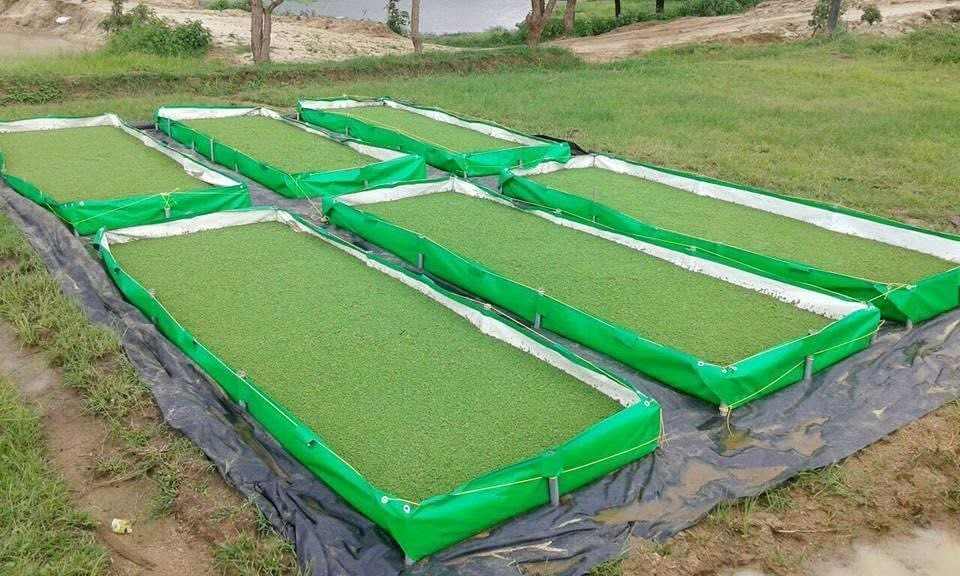Azolla, a fast-growing aquatic fern, is revolutionizing the livestock and agribusiness sectors across Africa. Known for its rapid growth and rich nutritional profile, Azolla offers a highly sustainable and cost-effective solution for livestock feed, organic fertilizers, and soil enrichment. With rising feed costs and a growing demand for eco-friendly farming practices, Azolla presents an exciting opportunity for investors looking to venture into an emerging and profitable agribusiness.
Why Invest in Azolla Farming?
- Low-Cost, High-Yield Business – Azolla cultivation requires minimal infrastructure, low water consumption, and limited manpower. With an ability to double its biomass within 3–5 days under optimal conditions, investors can expect high yields from minimal input.
- Sustainability and Environmental Benefits – Azolla has the unique ability to fix atmospheric nitrogen, enriching the soil naturally and reducing reliance on synthetic fertilizers. Additionally, it helps mitigate greenhouse gas emissions when used in rice paddies.
- High Demand for Livestock and Aquaculture Feed – As traditional feed ingredients like soybeans and maize become more expensive, Azolla offers an affordable and nutrient-rich alternative for livestock, poultry, and aquaculture industries.
- Multiple Revenue Streams – Beyond feed, Azolla has uses in organic farming as a biofertilizer, as a natural wastewater purifier, and even in biogas production, offering diversified income streams for investors.
- Ease of Cultivation – Adaptable to various climates, Azolla thrives in both rural and urban settings. This flexibility allows smallholder farmers, commercial agribusinesses, and urban agricultural entrepreneurs to incorporate it into their operations seamlessly.
Comprehensive Steps to Starting an Azolla Farming Business
1. Site Selection and Preparation
- Location Requirements: Azolla thrives in semi-shaded environments where it receives 5–6 hours of indirect sunlight daily. The site should be sheltered from heavy rain and strong winds.
- Water Source: A reliable, non-chlorinated water source is essential to maintain the Azolla’s growth cycle and health.
2. Constructing the Cultivation Unit
- Pond or Tank Setup: Construct a shallow pond, preferably 1–2 feet deep, using bricks or digging directly into the ground. Line it with plastic sheets or tarpaulin to prevent seepage and contamination.
- Nutrient Preparation: Fill the pond with water up to 10–12 inches and mix in cow dung slurry (around 2 kg per square meter) to enrich the water with essential nutrients. Supplement with phosphate fertilizers (superphosphate) to promote rapid growth.
- Introducing Starter Culture: Obtain high-quality Azolla culture from verified research institutes, agricultural universities, or commercial suppliers.
3. Proper Farm Management and Maintenance
- Temperature and pH Monitoring: Maintain water temperature between 20°C–30°C and a pH level of 5.5–7.5. Use pH strips and thermometers for accurate readings.
- Nutrient Replenishment: Refresh nutrient levels every 7–10 days by adding small amounts of cow dung slurry or organic compost.
- Pest Management: Regularly inspect the pond for pests such as aphids or moth larvae. Use organic pest control solutions like neem oil sprays when necessary.
- Water Quality Checks: Ensure water remains clear and free from algae, which can hinder Azolla’s growth.
4. Harvesting and Post-Harvest Handling
- Harvest Timing: Azolla doubles its biomass in 3–5 days and should be harvested every 7–10 days to prevent overcrowding.
- Harvest Method: Use a fine mesh net to scoop Azolla from the pond. Gently rinse it to remove any debris or excess nutrients.
- Drying: Spread the harvested Azolla under a shaded area for 2–3 days until thoroughly dried. Ensure good air circulation to prevent mold formation.
- Storage: Once dried, Azolla can be ground into powder, pelletized, or stored as flakes for long-term use.
Processing and Value Addition for Greater Profitability
- Fresh Azolla Feed – Used directly for livestock, poultry, fish, and even rabbits due to its high protein and mineral content.
- Sun-Dried Azolla Powder – Blended with conventional feed to improve the nutritional profile and reduce feeding costs.
- Pelletized Azolla Feed – Enhances storage life, simplifies transportation, and improves ease of use.
- Biofertilizer Production – Azolla enriches soil with nitrogen and boosts microbial activity, making it ideal for organic farming.
- Biogas Production – Can be mixed with animal manure to enhance methane production, creating a renewable energy source for farms.
Financial Projections and Market Opportunities
The profitability of Azolla farming lies in its low input costs and high demand. The market spans:
- Livestock and Poultry Farms: A cost-effective protein supplement for farmers looking to cut down on expensive feed.
- Fish Farms: Enhances growth rates and reduces feed costs for fish farmers.
- Organic Fertilizer Producers: An eco-friendly alternative to chemical fertilizers for crop production.
- Biogas Industry: Can be monetized as an energy supplement in rural areas.
A small-scale farm of 100 square meters can yield up to 1,000 kg of fresh Azolla monthly, with profit margins exceeding 50% depending on market prices and processing levels.
Challenges in Azolla Farming and Mitigation Strategies
- Water Contamination: Use clean, filtered water and conduct regular quality checks to prevent contamination.
- Temperature Fluctuations: Utilize shade nets during hot seasons and cover ponds during heavy rainfall.
- Market Penetration: Partner with cooperatives, engage in digital marketing, and offer product samples to attract new clients.
- Pest Infestation: Implement integrated pest management (IPM) strategies using organic repellents.
Conclusion: Why Now Is the Time to Invest in Azolla Farming
With the rising costs of livestock feed and increasing demand for sustainable farming solutions in Nigeria and across Africa, Azolla farming presents an untapped goldmine for investors. It offers multiple revenue streams, requires minimal investment, and contributes positively to environmental conservation. Entrepreneurs who tap into this growing market now will be well-positioned to lead in the future of sustainable agriculture and agribusiness innovation.


